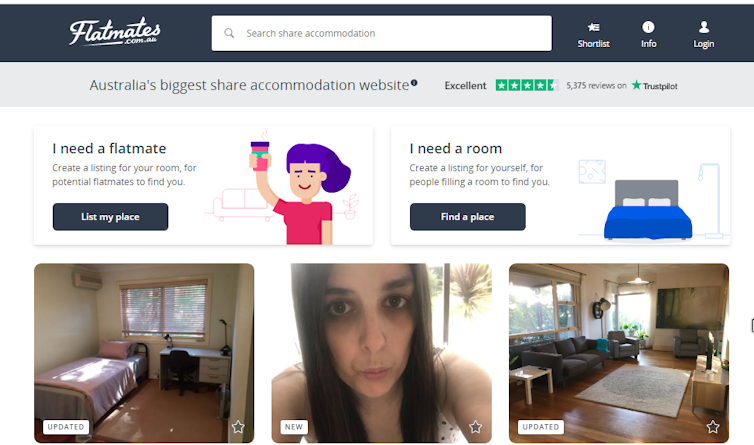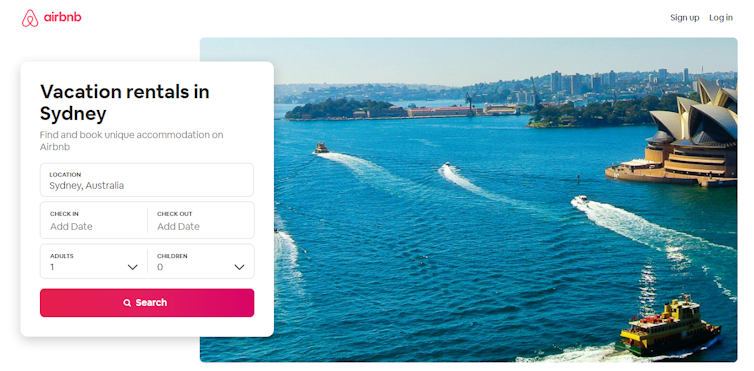What did COVID do to rental markets? Rents fell as owners switched from Airbnb
- Written by Caitlin Buckle, Research Associate in Housing Studies, University of Sydney
COVID-related travel restrictions and the sudden drop in tourism provided an ideal natural experiment to examine the impact of shifts in the supply of short-term rental accommodation. Our research, released today, found even modest reductions in Airbnb listings, as owners switched to longer-term rentals, increased supply of these properties. The result was lower local rents.
The COVID-19 pandemic caused various upheavals, with obvious impacts on health and employment, as well as a big drop in international migration. The impacts of these changes on rental markets are extremely difficult to track, particularly the impacts on people on the margins of the rental housing system. We investigated these impacts by analysing online listings on common online platforms for share/low-rent housing and short-stay accommodation.
Read more: As coronavirus hits holiday lettings, a shift to longer rentals could help many of us
Listings data show images, prices and descriptions of rental housing. These data provide an insight into this largely hidden sector of the housing market.
Of particular concern are people who:
What happened to these rentals?
Online platforms have transformed the ways in which people search for and advertise housing, so offer unique insights into the market.
We looked at listings of share housing and lower-cost rentals on Flatmates.com.au, Gumtree.com.au and Realestate.com.au between April and May 2020. We also looked at short-stay rentals on Airbnb.
Our primary focus was on Sydney, where Australia’s rental affordability pressures are most extreme.
We found demand for, and supply of, risky rental accommodation in Sydney continued during the pandemic.
In snapshots taken during lockdown restrictions in Sydney in April and May 2020, there were:
402 advertisements for rooms or granny flats on Gumtree.com.au in May
4,731 share accommodation listings on Flatmates.com.au in April
2,923 people seeking accommodation via Flatmates.com.au in April.
 Demand for and supply of shared accommodation on online platforms like Flatmates continued during the pandemic.
Flatmates
Demand for and supply of shared accommodation on online platforms like Flatmates continued during the pandemic.
Flatmates
Read more: COVID spurred action on rough sleepers but greater homelessness challenges lie ahead
Which renters are most at risk?
Of additional concern are older people in risky rentals who are more at risk of severe COVID-19 symptoms. More than 6,400 renters over the age of 60 lived in share (“group”) households in Sydney at the time of the 2016 census. It was estimated over 4,600 were homeless.
People working in public-facing roles such as healthcare workers, and in food and accommodation services are also at risk of virus transmission. Many of them live in unsuitable rental housing due to the low-paid and transient nature of their work.
According to the 2016 census, over 8,400 healthcare and social assistance workers were living in rented group households in Sydney. Over 1,800 were estimated to be homeless. One Flatmates.com listing clearly expressed the difficulties healthcare workers’ face when seeking a share rental during the pandemic:
For those who think I might have COVID just because I’m a nurse, I can assure you that I don’t have COVID!!! :P (Flatmates “person” listing, April 2020)
The difficulties lower-income renters face in Australia’s major cities reflect a chronic undersupply of social and affordable housing. Pre-pandemic studies suggested the rise of short-term accommodation platforms such as Airbnb added to these pressures by draining properties from the permanent rental supply.
Read more: As demand for crisis housing soars, surely we can tap into COVID-19 vacancies
What happened to short-term rental housing?
We looked at Airbnb listings in Sydney and Hobart between March and April 2020. Using Inside Airbnb data, we found the number of whole homes listed on Airbnb for more than 60 days a year decreased by 22% in Hobart and 14% in Sydney in that time.
 There were significant falls in home listings on Airbnb in Sydney and Hobart after the pandemic hit.
Airbnb
There were significant falls in home listings on Airbnb in Sydney and Hobart after the pandemic hit.
Airbnb
Vacancy rates, rental bonds data and Flatmates.com.au listings suggest these decreases occurred because Airbnb owners converted their properties into permanent rentals.
This translated to better outcomes for local renters. Even modest reductions in Airbnb listings were associated with increased permanent rental supply and lower local rents.
Median rents decreased in the June quarter in nine selected Sydney local government areas (LGAs) and Hobart’s four main LGAs. Rents fell by 2-9% in both cities.
Hobart was a particularly interesting case study because of its large penetration of Airbnb. The Airbnb market in Hobart City LGA is about 11% of the total private rental market. It experienced a much smaller drop in rental demand than Sydney because of its smaller number of temporary overseas migrants.
The drop in rents was directly proportional to the size of the Airbnb market in each LGA. Hobart City with an Airbnb density of 11% had a decrease in median rents of 9%. Glenorchy with an Airbnb density of 1% had only a 2% decrease in median rents.
Read more: Ever wondered how many Airbnbs Australia has and where they all are? We have the answers
How to improve life for renters on the margins
Our study contributes to a growing body of evidence on ways to improve the housing circumstances of lower-income renters and people at risk of homelessness.
Government action, such as increased JobSeeker and JobKeeper payments during the pandemic, has helped people to continue to pay rent and avoid resorting to precarious rental situations. However, even with these increases low-income renters can struggle to pay rent in unaffordable markets.
Obviously, increasing the supply of social and affordable housing would reduce dependence on the precarious and marginal rental market.
Similarly, a permanent increase in income-support payments such as JobSeeker and/or Commonwealth Rent Assistance would enable more households to get adequate housing without extreme financial stress.
Read more: $1 billion per year (or less) could halve rental housing stress
Higher regulation of the private rental sector would increase security for tenants and improve accommodation standards. We could look to New Zealand’s “healthy homes” framework for inspiration.
Finally, to preserve permanent housing supply in high-demand markets, states should impose controls on short-term Airbnb-style rentals.
These steps are critical to provide safe and secure accommodation for those on the margins of housing markets as part of Australia’s post-pandemic recovery.
Authors: Caitlin Buckle, Research Associate in Housing Studies, University of Sydney





